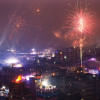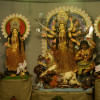Just when the Bengal sky starts wearing a calm shade of blue after a rainy monsoon and a lovely breeze sweep around dawn, I know in my heart that Durga Puja is around the corner. The Bengali Hindus wait for their biggest festival of joy and devotion every autumn. In most families, it is a preparation for a couple of months counting down to the Puja week.
It all starts with Kathamo Puja or Khuti Puja, a customary ritual to celebrate the day when the idol artisan starts off the sculpting process. It formally initiates the festivities as well as the preparation for the 5-day carnival. Also, it is a season for exchanging gifts with families and friends. The shopping and wrapping of gifts add to the joy of preparation.
Mahalaya signifies the beginning of Devi Paksha and the arrival of Maa Durga, thus ushering in the festive season. I grew up with the most common routine for the Bengali families on this day. Since the '30s, Bengalis tuned in to a magnificent audio presentation, 'Mahishasuramardini' at a serene hour before sunrise. It is a splendid recitation of the scriptural verses from 'Chandi Kavya' along with various devotional songs — a poignant production immortalised by Birendra Krishna Bhadra's timeless voice that narrates the story of Goddess Durga's descent on earth. Nowadays, some puja mandaps in Dhaka celebrate the occasion with a similar live presentation at the crack of dawn.
We attend the event wearing white, get excited by the eloquent recital and rhythm of dhaak and end the morning with a luchi-labra breakfast together.

The main festivities start after 5 days, on the day of Sasthi. On the eve of Durga Sasthi, the face of the idol of Goddess Durga is unveiled. The morning starts with 'Kalparambha' — a commitment to conduct the puja properly for the next five days, and at dusk, 'Bodhan' is performed to awaken the Goddess for the worship session that follows. All puja mandaps in Dhaka officially inaugurate the festival on Sasthi evening. To signify this inaugural day in a classic charm, I prefer wearing a white or cream sari with a wide red border, draped in Bengali style. Our favourite food for Sasthi is luchi with niramish alu dum, pumpkin and eggplant fritters, chholar daal with coconut, cottage cheese curry, etc.
Mahasaptami is the day that the legendary battle between Goddess Durga and the demon king Mahishasura began. The rituals start before sunrise with bathing a mirror that is personified as the deity of Goddess Durga. Also, a group of nine plants (nabapatrika) are tied together and offered to nine warrior manifestations of the mighty Goddess.
Saptami is our favourite day to hop pandals around town. My favourite colour for Saptami is a shade of blue or yellow. The pandal-hopping is paired with the joyful conversations around comparing the taste of bhoger khichuri and the artisanal quality of the idols between the pandals.
We traditionally consider the third day of the session, Maha Astami, to be the most auspicious and significant day. No one wants to miss the Anjali ritual of this day and as a result, the puja mandaps arrange a series of Anjali sessions across the day hours.
It is a day when the might and power of the Goddess is celebrated. Nine small pots are installed with nine shaktis of Durga being invoked in them. The weapons of the mighty Goddess are also worshipped through Astrapuja. The pandals get the biggest crowd throughout this day. Usually, we travel to places like Narayanganj or Mirzapore (Kumudini Complex) to enjoy this day in a traditional flavour. I always wear a shade of red, preferably vermillion red, accessorised with traditional jewellery to celebrate the elegance of this evening.

My most favourite ritual, Sandhi Puja, is performed on the night of Mahastami, more precisely at the juncture of Astami and Nabami tithi. It lasts from the last 24 minutes of Astami until the first 24 minutes of Nabami. During this window of Sandhikkhan, Devi Durga is worshipped in her Chamunda form and 108 earthen lamps are lit by married, female devotees. It is a lovely ritual where the puja stage looks stunningly beautiful with all the glowing lamps.
As soon as the Sandhi Puja ends, Mahanabami commences. Maha Aarti is performed as a closing ritual and just too many people flock in to take part in that. Since it is indeed the last day of the worship and the victory of the Goddess over the Demon is achieved, we usually celebrate the occasion with a delightful evening of music, dance, and arati at puja mandaps.
Everyone dresses up in their most gorgeous attire of the season. I love decking up in a dark flamboyant shade on Nabami evening.
Bijoya Dashami marks the day of farewell. I always found the cultural anecdote of this day a very sweet narrative — Durga along with her children visits her Baper Bari every autumn and returns to Kailash to her husband Lord Shiva at the end of vacation. So, just like every married girl's own family, the devotees are sad to see her off.

Before Bisarjan (immersion) of the idols, we celebrate the morning with Sindoor Khela wearing white attires, greet each other 'Shubho Bijoya' and take blessings of the seniors. It is truly a grand finale to the weeklong festivities and a wonderful day smeared with both joy and sadness.
Dancing and cheering with the Bisarjan procession on the open trucks used to be a lot of fun in my younger days. Mishtis are sent to all relatives and friends on the occasion of Bijoya Dashami. My childhood favourite sweet treats for Bijoya are still the hand-rolled laddoos and amritis. After saying goodbye to Maa Durga, we usually get together to have a great non-veg feast for dinner on Bijoya Dashami. Reminiscing all the delightful moments of the last five days, everyone whispers, ashchhe bochhor abar hobe! — "Adieu! Till next year!"








Comments